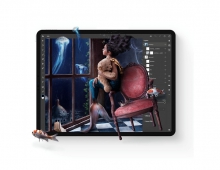
Latest Flash Player Supports Hardware Acceleration
Adobe's latest Flash player Ver.10.2 brings significant enhancements and takes advantage of hardware acceleration of the video rendering pipeline.
What's new:
Stage Video hardware acceleration
Leverage complete hardware acceleration of the video rendering pipeline with this new method for video playback. Dramatically decrease processor usage and enable higher frame rates, reduced memory usage, and greater pixel fidelity for best-in-class high-definition (HD) playback performance.
Internet Explorer 9 hardware accelerated rendering support
Take advantage of hardware accelerated graphics in Internet Explorer 9 with Flash Player, utilizing hardware rendering surfaces to improve graphics performance.
Native custom mouse cursors
Define custom native mouse cursors to enable user experience enhancements and improved performance.
Support for full screen mode with multiple monitors
Keep content in full-screen mode on multiple monitors, allowing you to see full-screen content while working on another display.
Sub-pixel text rendering Enhanced
Experience improved readability of text in Flash Player, especially for complex character-based languages.
Fast switch Enhanced
Show high quality video with streams that automatically adjust to changing network conditions. Leverage new quality-of-service metrics to provide a better streaming experience. Flash Player is enhanced to improve switching times between bitrates.
Accelerometer input
Leverage accelerometer input on supported devices for user input control and to control screen orientation. Read acceleration values in x, y, and z axes from native device accelerometer sensors, and specify the rate of accelerometer updates to conserve battery life.
Global error handling
Write a single error handler to process all runtime errors that were not part of a try/catch statement. Improve application reliability and user experience by catching and handling unexpected runtime errors, and present custom error messages.
Microphone access (desktop only)
Access binary data of the live and continuous waveform coming from the microphone to create new types of audio applications.
H.264 video hardware decoding
Deliver smooth video with minimal overhead across supported mobile devices and personal computers using H.264 video decoding. Hardware video decoding offloads tasks from the CPU, improves video playback performance, reduces system resource utilization, and preserves battery life.
Optimized SWF management for mobile (mobile only)
Optimize SWF loading and playback for mobile CPU and memory limitations to provide a better user experience. Instances are loaded or deferred based on developer-defined SWF priority, visibility, and available memory and CPU resources to enable more immediate browsing experiences without waiting for every SWF on a page to load. SWF playback automatically pauses when not in view to reduce CPU use, battery use, and memory use.
Sleep mode (mobile only)
Reduce CPU and battery consumption on mobile devices by slowing down the Flash Player timer when the mobile device goes into screen-saver or similar mode, with no interruption in audio/video playback. Incoming phone calls pause Flash Player.
Globalization support
Process text and lists and present information based on location context using operating system locale preferences or a specific format independent of the currently selected locale.
Browser privacy mode (desktop only)
Integrates support for private browsing mode in Chrome, Firefox, Internet Explorer, and Safari. Flash Player will not save any local storage data when private browsing is in use, helping to protect user privacy.
Support for mobile platforms
Enable content to reach users almost anywhere thanks to support for a broad range of mobile devices, including smartphones, tablets, smartbooks, and netbooks. Targeted mobile operating systems for Flash Player include Android, Palm webOS, and BlackBerry. A porting kit and Linux based reference implementation is available to Open Screen Project partners to port Flash Player to other platforms. Flash Player also adds support for Microsoft Windows 7 and Mac OS X v10.6 (Snow Leopard) desktop operating systems.
Multitouch and gestures
Take advantage of the latest hardware and operating system user interaction capabilities in Adobe Flash Player using new ActionScript 3.0 APIs for multitouch and native gesture events. Create multitouch-aware content for a wide range of devices and multitouch-capable machines. Interact with multiple objects simultaneously or work with native gestures, such as pinch, scroll, rotate, scale, and two-finger tap.
Content protection
(Desktop only; output protection Windows only; requires Adobe Flash Access 2) Play back media protected using Adobe Flash Access 2 in Flash Player to support a wide range of business models, including video on demand, rental, and electronic sell-through, for streaming as well as download. Using industry-standard cryptography, Adobe Flash Access 2 and Flash Player provide a robust environment to protect content so it remains safe from tampering or capture throughout its lifecycle. Output protection on Windows enables content providers to specify requirements for protection of analog and digital outputs, providing additional safeguards against unauthorized recording.
HTTP Dynamic Streaming
Deliver video on demand and live multibitrate streaming using standard HTTP infrastructure and SWF-level playback components. HTTP Dynamic Streaming enables expanded protocol options to deliver live and recorded media to Flash Player, including full content protection for HTTP streamed video with Flash Access 2.
Stream reconnect
Play RTMP streams through the buffer even if the connection is disrupted. Add reconnection logic in ActionScript to re-establish server connection and resume streaming without any disruption in the video.
Smart seek
Improve the seeking performance of streamed videos and enable the creation of slow motion, double time, or "instant replay" experiences for streaming video.
Buffered stream catch-up
Ensure that live video streaming stays in sync with real time over extended playback periods by setting a target latency threshold that triggers slightly accelerated video playback.
Peer-assisted networking Enhanced
Protect media delivery through the encrypted Real Time Media Flow Protocol (RTMFP) ? a more secure UDP-based network transport alternative to RTMP over TCP. Support for RTMFP groups allows clients to easily participate with other clients in a network in order to share the transport of media and communications without maintaining a connection to every peer in the group. Application-level multicast provides one-to-many (or a-few-to-many) streaming of continuous live video and audio or live video chat using RTMFP groups. Peer-assisted networking is available using Flash Media Server 4.
Periodic timer
Eliminate the dependency on different browser timer implementations to deliver consistent cross-platform behavior, significantly lower CPU utilization with nonvisible SWF content, and extend battery life. Nonvisible SWFs and SWFs on hidden tabs are throttled down to 2 frames per second. Frame rates of visible SWFs, timers, and local connections are limited and aligned to the player's periodic timer. Video can play back at any frame rate, increasing video playback fidelity.
Input method editor (IME) support Enhanced
Allow localized input by accessing operating system IMEs from within your application.
Out-of-memory management
Automatically prevent out-of-memory browser crashes by shutting down instances where a SWF file attempts to allocate more memory than is available on the device.
Mobile text input
Input text using native device virtual keyboards with TextField support if no physical keyboard is detected. A virtual keyboard is automatically raised and lowered when editing text on mobile devices supporting a virtual keyboard to enable unobstructed and intuitive text editing.
Audio hardware decoding
Reduce CPU load on mobile devices by using available hardware to accelerate audio decoding, avoiding CPU-intensive parsing and decompression. By freeing up CPU cycles for other operations, you improve battery life while still providing high-quality audio. In the absence of the hardware driver or required codec support, decoding falls back transparently to the software.
You cab download Adobe Flash Player 10.2.152.26 here (2.70MB)
Stage Video hardware acceleration
Leverage complete hardware acceleration of the video rendering pipeline with this new method for video playback. Dramatically decrease processor usage and enable higher frame rates, reduced memory usage, and greater pixel fidelity for best-in-class high-definition (HD) playback performance.
Internet Explorer 9 hardware accelerated rendering support
Take advantage of hardware accelerated graphics in Internet Explorer 9 with Flash Player, utilizing hardware rendering surfaces to improve graphics performance.
Native custom mouse cursors
Define custom native mouse cursors to enable user experience enhancements and improved performance.
Support for full screen mode with multiple monitors
Keep content in full-screen mode on multiple monitors, allowing you to see full-screen content while working on another display.
Sub-pixel text rendering Enhanced
Experience improved readability of text in Flash Player, especially for complex character-based languages.
Fast switch Enhanced
Show high quality video with streams that automatically adjust to changing network conditions. Leverage new quality-of-service metrics to provide a better streaming experience. Flash Player is enhanced to improve switching times between bitrates.
Accelerometer input
Leverage accelerometer input on supported devices for user input control and to control screen orientation. Read acceleration values in x, y, and z axes from native device accelerometer sensors, and specify the rate of accelerometer updates to conserve battery life.
Global error handling
Write a single error handler to process all runtime errors that were not part of a try/catch statement. Improve application reliability and user experience by catching and handling unexpected runtime errors, and present custom error messages.
Microphone access (desktop only)
Access binary data of the live and continuous waveform coming from the microphone to create new types of audio applications.
H.264 video hardware decoding
Deliver smooth video with minimal overhead across supported mobile devices and personal computers using H.264 video decoding. Hardware video decoding offloads tasks from the CPU, improves video playback performance, reduces system resource utilization, and preserves battery life.
Optimized SWF management for mobile (mobile only)
Optimize SWF loading and playback for mobile CPU and memory limitations to provide a better user experience. Instances are loaded or deferred based on developer-defined SWF priority, visibility, and available memory and CPU resources to enable more immediate browsing experiences without waiting for every SWF on a page to load. SWF playback automatically pauses when not in view to reduce CPU use, battery use, and memory use.
Sleep mode (mobile only)
Reduce CPU and battery consumption on mobile devices by slowing down the Flash Player timer when the mobile device goes into screen-saver or similar mode, with no interruption in audio/video playback. Incoming phone calls pause Flash Player.
Globalization support
Process text and lists and present information based on location context using operating system locale preferences or a specific format independent of the currently selected locale.
Browser privacy mode (desktop only)
Integrates support for private browsing mode in Chrome, Firefox, Internet Explorer, and Safari. Flash Player will not save any local storage data when private browsing is in use, helping to protect user privacy.
Support for mobile platforms
Enable content to reach users almost anywhere thanks to support for a broad range of mobile devices, including smartphones, tablets, smartbooks, and netbooks. Targeted mobile operating systems for Flash Player include Android, Palm webOS, and BlackBerry. A porting kit and Linux based reference implementation is available to Open Screen Project partners to port Flash Player to other platforms. Flash Player also adds support for Microsoft Windows 7 and Mac OS X v10.6 (Snow Leopard) desktop operating systems.
Multitouch and gestures
Take advantage of the latest hardware and operating system user interaction capabilities in Adobe Flash Player using new ActionScript 3.0 APIs for multitouch and native gesture events. Create multitouch-aware content for a wide range of devices and multitouch-capable machines. Interact with multiple objects simultaneously or work with native gestures, such as pinch, scroll, rotate, scale, and two-finger tap.
Content protection
(Desktop only; output protection Windows only; requires Adobe Flash Access 2) Play back media protected using Adobe Flash Access 2 in Flash Player to support a wide range of business models, including video on demand, rental, and electronic sell-through, for streaming as well as download. Using industry-standard cryptography, Adobe Flash Access 2 and Flash Player provide a robust environment to protect content so it remains safe from tampering or capture throughout its lifecycle. Output protection on Windows enables content providers to specify requirements for protection of analog and digital outputs, providing additional safeguards against unauthorized recording.
HTTP Dynamic Streaming
Deliver video on demand and live multibitrate streaming using standard HTTP infrastructure and SWF-level playback components. HTTP Dynamic Streaming enables expanded protocol options to deliver live and recorded media to Flash Player, including full content protection for HTTP streamed video with Flash Access 2.
Stream reconnect
Play RTMP streams through the buffer even if the connection is disrupted. Add reconnection logic in ActionScript to re-establish server connection and resume streaming without any disruption in the video.
Smart seek
Improve the seeking performance of streamed videos and enable the creation of slow motion, double time, or "instant replay" experiences for streaming video.
Buffered stream catch-up
Ensure that live video streaming stays in sync with real time over extended playback periods by setting a target latency threshold that triggers slightly accelerated video playback.
Peer-assisted networking Enhanced
Protect media delivery through the encrypted Real Time Media Flow Protocol (RTMFP) ? a more secure UDP-based network transport alternative to RTMP over TCP. Support for RTMFP groups allows clients to easily participate with other clients in a network in order to share the transport of media and communications without maintaining a connection to every peer in the group. Application-level multicast provides one-to-many (or a-few-to-many) streaming of continuous live video and audio or live video chat using RTMFP groups. Peer-assisted networking is available using Flash Media Server 4.
Periodic timer
Eliminate the dependency on different browser timer implementations to deliver consistent cross-platform behavior, significantly lower CPU utilization with nonvisible SWF content, and extend battery life. Nonvisible SWFs and SWFs on hidden tabs are throttled down to 2 frames per second. Frame rates of visible SWFs, timers, and local connections are limited and aligned to the player's periodic timer. Video can play back at any frame rate, increasing video playback fidelity.
Input method editor (IME) support Enhanced
Allow localized input by accessing operating system IMEs from within your application.
Out-of-memory management
Automatically prevent out-of-memory browser crashes by shutting down instances where a SWF file attempts to allocate more memory than is available on the device.
Mobile text input
Input text using native device virtual keyboards with TextField support if no physical keyboard is detected. A virtual keyboard is automatically raised and lowered when editing text on mobile devices supporting a virtual keyboard to enable unobstructed and intuitive text editing.
Audio hardware decoding
Reduce CPU load on mobile devices by using available hardware to accelerate audio decoding, avoiding CPU-intensive parsing and decompression. By freeing up CPU cycles for other operations, you improve battery life while still providing high-quality audio. In the absence of the hardware driver or required codec support, decoding falls back transparently to the software.
You cab download Adobe Flash Player 10.2.152.26 here (2.70MB)





















